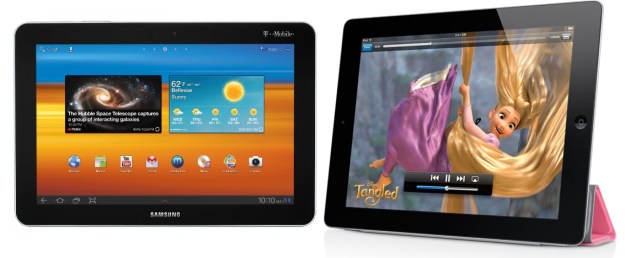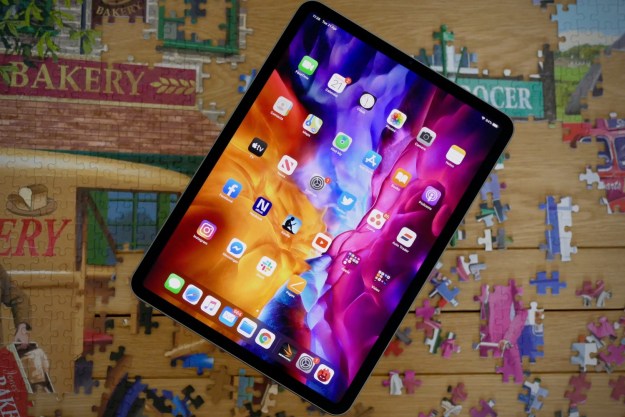
When Apple announced the iPad in January 2010, a significant portion of the technology industry thought Steve Jobs had a flop on his hands. Although some greeted the iPad announcement with unbridled enthusiasm, many others shrugged the device off as merely a “big iPhone.” Underpowered, overpriced and lacking must-have features like a camera, keyboard, and USB. Yet the iPad and its successor the iPad 2 have essentially defined the tablet computing industry. The crucial question for every tablet that’s come to market since has been “why would someone buy this instead of an iPad?” So far, the most answer is usually “no reason.”
So where are the iPad’s competitors, how did the iPad reach this level of success, and does the iPad actually have an Achilles heel competitors can exploit?
Where’s Android today?
The iPad’s domination of the tablet market is hard to underestimate, but some people try. Strategy Analytics recently published a report analyzing OS market share for tablets in the third quarter of 2011. It paints one of the rosiest pictures yet for iPad competitors, claiming Apple only had two thirds of the worldwide tablet market. That still seems like an unsurmountable lead, but Strategy Analytics noted that was down from 95.5 percent the year before, and that 26.9 percent of the global market had been claimed by Android tablets. That’s some 4.5 million Android units compared to Apple’s 11.1 million iPads.
That might be encouraging for iPad competitors… if it were true. Apple regularly discloses how many iPad units it has sold, so the 11.1 million figure for the quarter can be taken at face value. However, Strategy Analytics has admitted to GigaOm that its figure of 4.6 million Android tablets includes the number of units that have shipped, not sold; tablets sitting in stores and on warehouse shelves are counted the same way as iPads in customers’ living rooms and book bags. Furthermore, Strategy Analytics included all sub-versions of Android in its totals, including devices running versions before the tablet-optimized Honeycomb. The report also tallied in the Barnes & Noble Nook Color e-reader, which can be converted to a full Android tablet by the technically inclined, but isn’t sold as one. In short, the survey essentially counts every non-smartphone Android-running device that can be vaguely construed as a tablet, and compares that figure to iPads people have actually bought.
GigaOm‘s Kevin Tofel takes a shot at more accurate number for Android tablets, based on Android activation figures disclosed by Andy Rubin at Google’s Ice Cream Sandwich rollout placed against Android Market access figures. By that accounting, the number of Android 3.0 tablets currently in users’ hands seems to be about 3.4 million.
That figure includes all Android 3.0 devices, however, not just tablets sold during the third quarter, so it can’t be compared directly with Strategy Analytics’ figures. The first Android 3.0 device (the Motorola Xoom) went on sale in February 2011. During its most recent two quarters (a roughly equivalent period running from late March through late September — we’ll give Android 3.0 a month’s head start), Apple sold 20.37 million iPads. That generously gives Android about 14 percent of the tablet market since the introduction of Android 3.0, considering just iPads and Android devices. The figure would be a bit lower if we figured in sales of tablets like the HP TouchPad, the RIM PlayBook, and Windows-based tablets…and if we included iPad sales from February.
Why haven’t Android tablets taken off?
Android would seem to have all the advantages over the iPad. Setting aside debates about the meaning of “open” for the time being, Android devices are available from a variety of different manufacturers with designs designed to meet many different needs. Android tablets come in a variety of screen sizes and form factors, and in many cases offer screen resolution, graphics, and hardware specs that match or exceed the iPad. As a platform, Android tablets can be very diverse, where the iPad is famously one-size-fits all: Users’ only real choices are the amount of built-in storage and whether they want 3G capability.
Apple wouldn’t have been able to launch the iPad successfully if the iPhone didn’t already have serious market momentum: Apple was not only able to leverage a vast pool of applications and an already-mature touch-centric mobile operating system for the iPad, but was also able to lock in suppliers. Apple famously maintains a strong lock on the worldwide market for the 9.7-inch displays used in the iPad. They’re made by Samsung and LG, and DisplayBank found Apple snapped up 83 percent of all 9.7-inch displays made during May, or some 4.5 million units. (A small portion of the remainder went to the HP TouchPad.) Apple obviously doesn’t buy that many displays every month, but its orders clearly account for a huge portion of the market. Apple also has favorable arrangements with companies like Samsung to keep iPads flush with flash memory, and Apple’s new CEO Tim Cook is well-known for playing hardball with suppliers to keep Apple’s costs down, and suppliers have even complained Apple has strong-armed for low prices then cut their orders once a deal has been inked.

Android fragmentation and the Android Market
Google has been working hard to make Android a serious competitor in the tablet arena, and the forthcoming Android 4.0 Ice Cream Sandwich release, which claims to do away with the distinction between phones and tablets, looks to be a step in that direction. There’s an almost tacit acceptance now that Android is basically equivalent to Apple’s iOS, but it doesn’t take long working with them both — especially on tablets — to see that’s often not yet true. Android sometimes offers stunning performance, but just as often stalls or hiccups for no apparent reason: Simple scrolling is usually great place to see the difference. Apple’s iOS offers remarkably consistent interface, even across many third-party apps, where Android continues to be a mishmash of styles and metaphors, and often labors under third-party patinas that make matters even more confusing for everyday users. In short, iOS was tuned for the iPad when it debuted, but with Android 3.0 Google struggled to shoehorn a smartphone operating system into tablets, and is still sweating many of the details. Android generally works, but it often doesn’t work all that great.

How to kill the iPad?
Google is pressing the Android platform forward with Ice Cream Sandwich, and the next version of Android holds a great deal of promise. However, it’s not clear that Ice Cream Sandwich alone is going to make Android tablets compelling in the marketplace alongside the iPad. The question will still be “Why by an Android tablet instead of an iPad?” For many consumers, Ice Cream Sandwich isn’t going to change the answer very much.
Instead, the way for Android tablets to gain marketshare against the iPad might be to take the path of the Barnes & Noble Nook and the forthcoming Kindle Fire: use the “free and open” Android as a base platform for low-cost, purpose-built devices. For the Nook Color and the Fire, that’s based purely on media consumption (books and video), but as Android evolves it could make a compelling platform for gaming devices, navigation systems, home automation, social media tool, or other devices that we haven’t even imagined yet.

After all, the iPad is designed as be a general purpose device. Historically, general purpose devices tend to be more expensive than specialized products, and don’t excel at specialized tasks. After all, you can take a Corolla onto a race track or out on a two-track dirt road… but it wouldn’t be your first choice.
The iPad’s current success is based on defining the tablet market: Right now, for most consumers, “tablet” and “iPad” are synonymous. But most iPad customers don’t use most of the iPad’s capabilities: instead, it’s mainly a Web browser, a video playback device, an email client, a social media tool, an ereader, or a gaming platform. That flexibility aids the iPad, but it would be difficult to recommend the iPad solely as an ereader, video viewer, or any one of those things, at least on a cost basis. By focusing doing particular tasks very well, Android tablets could gain market share by eliminating general-purpose features they don’t need and substantially undercutting the iPad’s price.
It’s just not very glamorous.
Editors' Recommendations
- How to download iPadOS 18 on your iPad right now
- Best Prime Day tablet deals: What to expect in 2024
- Everything Apple announced at WWDC 2024: iOS 18, AI, and more
- I used an iPad as my main camera, and what happened amazed me
- Apple just admitted defeat to Android phones


